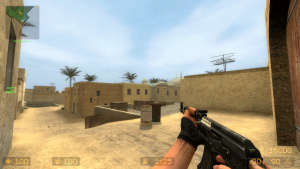Source
As a courtesy, please do not edit this while this message is displayed.
If this page has not been edited for at least several hours to a few days, please remove this template. This message is intended to help reduce edit conflicts; please remove it between editing sessions to allow others to edit the page.
The person who added this notice will be listed in its edit history should you wish to contact them.
You can help by finishing the translation.
If this page cannot be translated for some reason, or is left untranslated for an extended period of time after this notice is posted, the page should be requested to be deleted.
Also, please make sure the article complies with the alternate languages guide.
This notice is put here by LanguageBar template and if you want to remove it after updating the translation you can do so on this page.
Note: Apenas jogos Primarios da Valve.
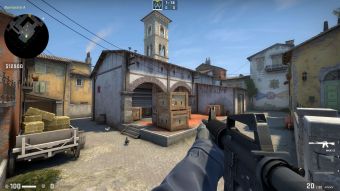
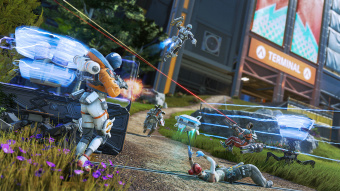
![]() Source É um motor gráfico 3D criado pela
Source É um motor gráfico 3D criado pela ![]() Valve em 2004, e é o sucessor da GoldSrc. O Motor Source é bem conhecido pelo seus avanços em física, IA, e gráficos que fizeram jogos realistas para seu tempo, ao mesmo tempo que é escalável em hardware mais antigo e menos potente. Half-Life 2 ganhou vários prêmios por seus gráficos, que foram possíveis graças ao Source. Source foi utilizada pela Valve, corporações de terceiros, e (parecido com a Goldsrc) incontáveis mods feitos pela comunidade ao redor do globo, com pelo menos 100 jogos desenvolvidos na Source. O motor tem varias ramificações, cada uma contendo uma função adicionada e improvisando as capacidades gráficas.
Valve em 2004, e é o sucessor da GoldSrc. O Motor Source é bem conhecido pelo seus avanços em física, IA, e gráficos que fizeram jogos realistas para seu tempo, ao mesmo tempo que é escalável em hardware mais antigo e menos potente. Half-Life 2 ganhou vários prêmios por seus gráficos, que foram possíveis graças ao Source. Source foi utilizada pela Valve, corporações de terceiros, e (parecido com a Goldsrc) incontáveis mods feitos pela comunidade ao redor do globo, com pelo menos 100 jogos desenvolvidos na Source. O motor tem varias ramificações, cada uma contendo uma função adicionada e improvisando as capacidades gráficas.
Apesar do motor source estar na casa dos 20 anos, já sendo ultrapassado e substituído pelo ![]() Source 2 como motor principal partir de 2015. O motor continua sendo amplamente utilizado pela comunidade de modding e corporações de terceiros pelo fato da {{source2|4.1} não ter tantos documentos explicativos de utilização e raramente ser licenciado pela valve para desenvolvedores de terceiros comparado ao source, ainda sendo mantido regularmente com atualizações de segurança e ate mesmo melhorias para o próprio motor.
Source 2 como motor principal partir de 2015. O motor continua sendo amplamente utilizado pela comunidade de modding e corporações de terceiros pelo fato da {{source2|4.1} não ter tantos documentos explicativos de utilização e raramente ser licenciado pela valve para desenvolvedores de terceiros comparado ao source, ainda sendo mantido regularmente com atualizações de segurança e ate mesmo melhorias para o próprio motor.
Recursos
Lista de recursos e capacidades para o motor ![]() Source. Alguns recursos novos listados aqui podem não se aplicar para ramificações antecessores ou superiores da Source, ou jogos/ramificações de terceiros.
Source. Alguns recursos novos listados aqui podem não se aplicar para ramificações antecessores ou superiores da Source, ou jogos/ramificações de terceiros.
Para uma lista de Ramificações da Source (incluindo jogos de terceiros) com seus recursos específicos veja esta categoria.
Renderização
- Suporta modelos 2.0 e 3.0 do Shader.
- Suporte a Anti-serrilhamento (MSAA, FXAA, MLAA, TAA, etc.)
- Veja a pagina do anti-serrilhamento para mais informações, recursos e desvantagens, com vários métodos de anti-serrilhado.
- Mais opções de filtragem de textura e anisotrópicas.
- Filtros Anisotrópicos permitindo texturas em varias distancias deixando-as finas e menos borradas.
- Comparado ao GoldSrc (anterior a 2013) fornecendo apenas filtragem de textura bilinear ou trilinear, a Source fornece mais opções de filtragem de textura, indo de bilinear, trilinear, anisotrópico 2x ate 16x.
- Suporte para pipelines de renderização tanto forward quanto deferred.
- Renderização Deferred é uma técnica de renderização que permite jogos a renderizar muitas luzes com baixo impacto na performance. Renderização Deferred são utilizados naturalmente na maioria dos títulos modernos.
- Bump mapping e Normal mapping em modelos do mundo
- Autor shaders com HLSL
- Cubo e mapeamento de ambiente
- Cubemapping também suporta Anisotropia (em todos os jogos desde csgo)
- Phong, sombreamento para modelos
- Inclui vários tipos de luzes como Luzes dinâmicas, luzes vertex, lightmaps, flickering, pulsing etc.
- HDR (em todos os jogos desde
 ) e luzes LDR (SDR)
) e luzes LDR (SDR)
- LDR é obsoleto desde
 Left 4 Dead engine branch. Isto não se aplica a alguns jogos como exemplo os lançamentos originais de
Left 4 Dead engine branch. Isto não se aplica a alguns jogos como exemplo os lançamentos originais de  Dota 2.
Dota 2.
- LDR é obsoleto desde
- Água com refração, reflexões em tempo real e efeitos fresnel.
- Água também suporta flow mapping (em todos os jogos desde
 )
)
- Água também suporta flow mapping (em todos os jogos desde
- Sistema de Partículas Avançadas que pode emitir sprites ou models
- Sombras de Renderização para textura permitem uma quantidade maior de caracteres por cena (em todos os jogos desde
 ) (também em
) (também em 
 )
) - Oclusor de entidades para bloqueio de visibilidade.
- Ambientes internos e externos
- Terreno deformável
- Skyboxes em 3D expandem o horizonte e adicionam parallax em objetos distantes.
- Renderização orgânica dinâmica (folhas, arvores, etc.)
- Balanço de arvores (em todos os jogos desde
 ) (também em
) (também em 


 )
)
- Subdivisão de superfície, difusão e mapas de colisão especular
- Iluminação de radiosidade em tempo real
- Mapeamento de sombra em cascata em tempo real que vem da skybox (em todos os jogos desde
 ) (também em
) (também em 

 )
) - Efeitos incluem mas não são limitados á: Partículas, feixes, fumaça volumétrica, faíscas, sangue e efeitos do ambiente como neblina e chuva.
- Escalabilidade
- Oclusão Ambiental em Espaço de Tela (SSAO) (apenas em

 )
)
- Uma técnica para eficientemente aproximar o efeito de oclusão de ambiente em tempo real.
- Suporte para tela panoramica
- Source é um dos primeiros motores gráficos á suportar nativamente monitores panorâmicos (proporção 16:9 e 16:10) sem precisar esticar a imagem, emquanto a maior parte dos jogos daquela era são geralmente projetados apenas para proporções de exibição 4:3/5:4.
Jogos como Half-Life 2 oferecem suporte a exibição panorâmica desde 2004, com FOV (Field of View/Campo de Visão) horizontal permitindo uma visão mais detalhadas.
- Source é um dos primeiros motores gráficos á suportar nativamente monitores panorâmicos (proporção 16:9 e 16:10) sem precisar esticar a imagem, emquanto a maior parte dos jogos daquela era são geralmente projetados apenas para proporções de exibição 4:3/5:4.
- Base de física Renderizada (apenas em




 )
) - Mapeamento de oclusão parallax(apenas em xe)
- Suporte a varias APIs gráficas (Direct3D, OpenGL, Vulkan, etc)
- Versões do Direct3D
- Direct3D 9
- Níveis de compatibilidade do DirectX para placas gráficas mais antigas:
- DirectX 7.0 (Source 2004/2006 ou jogos RTX Remix apenas)
- DirectX 8.0 (
dxlevel 80arrumado a função shaders) - DirectX 8.1 (
dxlevel 81o mesmo de cima, com suavidade nas sombras) - DirectX 9.0 (
dxlevel 90) - DirectX 9.0+ (
dxlevel 95)  Notar: Compatibilidade com níveis de DirectX não são suportados atualmente desde Left 4 Dead engine branch.
Notar: Compatibilidade com níveis de DirectX não são suportados atualmente desde Left 4 Dead engine branch.
Além disso, independentemente de qualdxlevelfoi selecionado, todos os jogos Source irão rodar Direct3D 9.
- Direct3D 9Ex (em todos os jogos desde
 ) (também em
) (também em  ) - Extensão do Windows Aero DX9 requer Vista ou superior. Usuário pode habilitar ou desabilitar nas configurações de vídeo - Avançado (Extensão Windows Aero) ou por
) - Extensão do Windows Aero DX9 requer Vista ou superior. Usuário pode habilitar ou desabilitar nas configurações de vídeo - Avançado (Extensão Windows Aero) ou por -disable_d3d9ex; (apenas em )
) - Direct3D 11 (apenas em


 )
) - Direct3D 12 (apenas em
 )
)  Notar:Direct3D 9 pode ser forçado pelas opções de inicialização via
Notar:Direct3D 9 pode ser forçado pelas opções de inicialização via -dx9, caso ele for forçado por comandos como por exemplo-gamepadui, que habilita ambos Gamepad UI e renderização Vulkan a menos que combinado com-dx9
- Direct3D 9
- OpenGL(em todos os jogos desde
 /
/ ) que é outra API gráfica usada em jogos Source no macOS e Linux.
) que é outra API gráfica usada em jogos Source no macOS e Linux.
dxlevel 92é o equivalente do OpenGL ao DirectX 9 Shader Model 3 (D3D9.0c)
- Vulkan API gráfica (apenas em





 )
)
- O sucessor do OpenGL, Vulkan pode ser usado para gambiar vários problemas gráficos como o as texturas projetadas de portal 2, que não renderiza apropriadamente em novos drivers gráficos (ambos NVidia e AMD). Habilitar Vulkan usando
-vulkannas opções de inicialização.
- O sucessor do OpenGL, Vulkan pode ser usado para gambiar vários problemas gráficos como o as texturas projetadas de portal 2, que não renderiza apropriadamente em novos drivers gráficos (ambos NVidia e AMD). Habilitar Vulkan usando
Sistema de Materiais
- Instead of traditional textures, Source defines sets of materials that specify what the object is made from and the texture used for that object. A material specifies how an object will fracture when broken, what it will sound like when broken or dragged across another surface, and what that object's mass and buoyancy are. This system is much more flexible than other texture-only systems
- Materials can interact with objects or NPCs, such as mud or ice for vehicles to slide/lose traction on
Multiplayer Network Code
- Time- and gamer-tested by millions of gamers around the world
- Support for both LAN-based multiplayer and Internet-based multiplayer games
- Prediction analysis for interpolating collision/hit detection
- Optimizations for high-latency, high-packet-loss 56k connections
Advanced Characters
- Detailed and believable characters
- Realistic eyes
- Focus on player/object, not simply parallel views
- Proper eye bulge for realistic eye reflections
- Simulated musculature provides outstanding emotions, speech, and body language
- Language independent speech, characters can speak naturally in many languages
- Skeletal/bone system for animation
- Layered animation system can synthesize complex animations out of several pieces
Physics
- Uses Havok physics engine, licensed from Havok Group (now acquired by Microsoft)
- More responsive world with realistic interactions
- Sounds & graphics follow from physics
- AI characters can interact with physically simulated objects
- Ropes/cables, machines, constraint systems, ragdoll physics
- Can be controlled by level design
- Kinematic animated bone followers
- Custom procedural physics controllers
- Vehicles
- Wheels slip and skid
- Realistic suspensions with springs on each wheel
- Realistic leaning during acceleration/deceleration and turning
- Individually tunable parameters such as horsepower, gearing, max speed, shift speed, tire material, tire friction, spring tension/dampening, etc.
- Multiple players in a vehicle in multiplayer
- Hovercraft support for cheaper simulation
Advanced AI
- I/O system allows level designers to control AI
- Sophisticated navigation: characters that run, fly, jump, crouch, climb stairs and ladders, and burrow underground
- AI senses things using sight, sound, and smell
- AI relationships determine friend/foe status of other entities
- Battle AI allows squads of AI characters to operate together, know when to advance, retreat, lay cover fire, etc.
Sound System
- 7.1, 5.1 surround sound, 4 speaker surround
 Erro:On system running Windows Vista and later, due to the game engine using DirectSound and older version of Miles Sound System, the game may output only 5.1 surround despite 7.1 selected or 7.1 audio may not work properly without custom
Erro:On system running Windows Vista and later, due to the game engine using DirectSound and older version of Miles Sound System, the game may output only 5.1 surround despite 7.1 selected or 7.1 audio may not work properly without custom dsound.dll(such as Creative Alchemy, DSOAL or IndirectSound). This issue is not affected by some third-party games, such as Titanfall 2, Apex Legends as they used newer version of Miles Sound System. [todo tested in ?] Notar:Some or newer Source games (such as Alien Swarm, Portal 2 and Counter-Strike: Global Offensive) may not include options to enable 7.1 surround sound without using console commands.
Notar:Some or newer Source games (such as Alien Swarm, Portal 2 and Counter-Strike: Global Offensive) may not include options to enable 7.1 surround sound without using console commands.
- High-quality 3D spatialization
- Custom software DSP
- Automatic DSP based on environmental geometry
- Microsoft ADPCM-compressed WAV files
- 16-bit 44.1 KHz (CD Quality), stereo wave data with all features
 Notar:Source does not support 48 KHz audio (DVD Quality) by default.
Notar:Source does not support 48 KHz audio (DVD Quality) by default.
- MP3 decompression (requires Miles license)
- Support for audio streaming on any wave [Clarify]
- Real-time wave file stitching [Clarify]
- Pre-authored Doppler effect encoded waves
- Pre-authored distance variant encoded waves
- Commentary system
UI
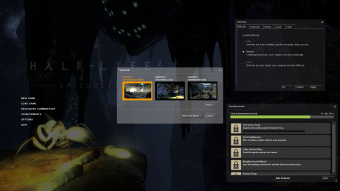
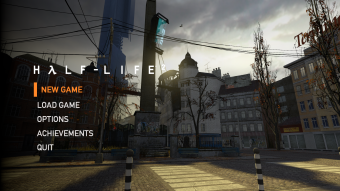
- Server browser — Displays all active game servers and allows a player to choose which one to participate in. Players can filter and sort server lists to speed up the display and selection of a server.
- VGUI — Valve's custom GUI interface mimics most of the Windows controls but is rendered using the Source engine for both in game and out of game uniform UI display. Some features:
- Dynamic in-game HUD display
- Many widgets/controls (e.g., buttons, treeview, html control…)
- Themes/custom visualization allowed
- Platform independent
- Localized text (Unicode compliant)
- Gamepad UI (
 Source 2013 version) — Since the release of Half-Life 2 (and its episodes) as well as Portal updates in 2022, Valve have added a modern UI which is designed for consoles and handhelds like
Source 2013 version) — Since the release of Half-Life 2 (and its episodes) as well as Portal updates in 2022, Valve have added a modern UI which is designed for consoles and handhelds like  Steam Deck. With the new Gamepad UI, it was more scalable across any resolution (including 4K and higher), unlike the regular VGUI (which, the higher the resolution, the text and UI will become smaller). This UI can be also enabled manually by using
Steam Deck. With the new Gamepad UI, it was more scalable across any resolution (including 4K and higher), unlike the regular VGUI (which, the higher the resolution, the text and UI will become smaller). This UI can be also enabled manually by using -gamepaduicommand line argument (which will also enable Vulkan renderer that may not work on some older GPUs unless-dx9is used in combination of-gamepadui).
- Scaleform (officially called Scaleform GFx) — Introduced with CS:GO engine branch at launch until 2018, this is a vector graphics rendering engine used to display Adobe Flash-based UI and HUD for games.
- Panorama (em todos os jogos desde
 ) — Introduced in 2018, replacing Scaleform, Valve's new Custom GUI interface that resembles modern web design and authoring (HTML5/CSS/JS). Using
) — Introduced in 2018, replacing Scaleform, Valve's new Custom GUI interface that resembles modern web design and authoring (HTML5/CSS/JS). Using .XMLand JavaScript files, developers can create dynamic and clean HUDs and menus and even high-quality in-game intractable panels.
Programming
- Source natively support various CPU architectures, such as x86 (PC and 8th, 9th-gen Consoles), ARM (
 Android,
Android,  Nintendo Switch), PowerPC (
Nintendo Switch), PowerPC ( Xbox 360,
Xbox 360,  PlayStation 3), and more, with both 32 and 64-bit.
PlayStation 3), and more, with both 32 and 64-bit.
- Support for 64-bit architecture will allow Source to handle more than 2-4GB of RAM limit.
- Historically, Half-Life 2 had a 64-bit update in 2005, but it was later removed for unknown reasons. CS:GO later received an 64-bit update in 2016 for Mac and Linux systems. On April 19, 2024, Team Fortress 2 was upgraded to 64-bit on Windows and Linux.
- All code written in C/C++ using Visual Studio .NET 2003 and later. Easily and quickly derive new entities from existing base classes
- Source SDK 2013 code, by default, can be compiled on Visual Studio 2013 only. See Compiling under VS2022 if you want to compile Source 2013 with newer versions of Visual Studio.
- Linux version are compiled using GNU Compiler Collection.
- Internal context sensitive performance monitoring system
- Graphics performance measurement tools built into the engine
- Modular code design (via DLLs) allows swapping out of core components for easy upgrading or code replacement
- VScript scripting system allows using external coding languages, such as Squirrel and Lua, in maps to create more complex systems (em todos os jogos desde
 ) (também em
) (também em 
 )
)
Tools
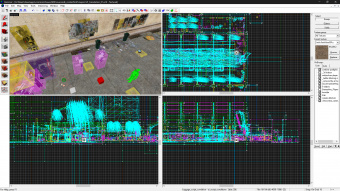
 HLFaceposer
HLFaceposer
- Facial expression tool used to craft speech and emotions
 Valve Hammer Editor
Valve Hammer Editor
- WYSIWYG World editor
- Create world brushes
- Terrain editor
- Place detailed world models and AI NPCs
- Set navigation points/paths for NPCs
- Place triggers, clip brushes, logic, etc.
- Allows level designer to hook up I/O between entities to control AI within the game
 Half-Life Model Viewer
Half-Life Model Viewer
- Full model previewer
- Rotate models in any direction
- Set up hit boxes
- View physics hull
- View normals
- Wireframe, shaded or textured view modes
- Studiomdl
- Model compiler
- VBSP, VRAD, VVIS, VMPI
- Map compilation tools (bsp, lighting and visibility)
- VMPI — distributed compilation tool allowing level compiles to be spread across many PCs greatly reducing compile times
- Exporters
- XSI, Max and Maya
.smdexporters for exporting 3D models
- XSI, Max and Maya
Branches
- For the list of Source engine branches (including third-party branches), see List of Source engine branches.
Products using Source 



This is the list of games that uses the ![]() Source engine.
Source engine.
Products made by Valve
| Release date | Title | Co-developed with | Engine branch | Platforms | Notes |
|---|---|---|---|---|---|
| 7 out. 2004 | |
Turtle Rock Studios Hidden Path Entertainment (2010 update) |
|
PC: Windows, Mac, Linux | First game to use the Source engine. Remake of Counter-Strike. Hidden Path Entertainment alongside Valve worked on the May 7, 2010 update, which upgraded the game's engine from Source 2006 to 2009 (MP version, later renamed to Source MP), and added 144 (now 146) achievements, a new domination and revenge system similar to Team Fortress 2, player stats and more. Hidden Path Entertainment also worked on the unreleased Xbox 360 port of CS:S, which would later become |
| 16 nov. 2004 | |
|
PC: Windows, Mac, Linux | Remaster of Half-Life. It is critically panned by most gamers since 2013 due to the huge amount of bugs that were introduced when the game was updated to A unofficial fan remake of Half-Life, called Black Mesa was later started development in response of those criticisms, which was first released in 2012 without any Xen chapters and was much shorter, and later in 2020, a full release with contains the Xen chapters. |
|
| 16 nov. 2004 | |
EA UK (PS3 port) | |
PC: Windows, Mac, Linux Console(s): Original Xbox, Xbox 360, PlayStation 3 |
Sequel to Half-Life, and later Half-Life: Alyx. Included on The game was set 20 years after the event of Half-Life, takes place in City 17, which is under Combine control. Prior to its release, it was delayed multiple times, and infamously leaked in Oct 2003. It was among the first games to require Steam in order to play. Half-Life 2's engine branch has been updated multiple times, first in 2007, upgraded to Source 2007 only on consoles, and in 2010, upgraded to Source 2009 on PC, and finally, Half-Life 2 was upgraded to the Source 2013 Singleplayer branch. In November 2024, Valve released a 20th anniversary update, which add Steam Workshop support, fixing several bugs, improved shaders (with option to use classic 2004/2006 particles/effects and Very High shader option), and made Half-Life 2: Lost Coast, Episode One and Episode One playable through Half-Life 2 main menu, without quitting the game and launch it separately on Steam client. |
| 30 nov. 2004 | |
|
PC: Windows, Mac, Linux | Multiplayer component of Half-Life 2. Now runs on Team Fortress 2 branch after 20th anniversary update. | |
| 26 set. 2005 | |
|
PC: Windows, Mac, Linux | Remake of Day of Defeat. Like Half-Life 2: Lost Coast, it also have features later added to Source 2006, such as HDR lighting. | |
| 27 out. 2005 | |
|
PC: Windows, Mac, Linux | Originally as part of Half-Life 2, which was cut at some point before it was released, and was developed after the leak happened but was ultimately cut, then later released in 2005 as a HDR lighting technology demo. It runs on a newer version of Source 2004, introducing new features such as Commentary System and HDR (which was previously introduced on Day of Defeat: Source). Both of these new features are later used in Half-Life 2: Episode One, which runs on Source 2006 engine, and subsequent games & branches after it. As of 2025, it runs on |
|
| 1 mai. 2006 | |
|
PC: Windows, Mac, Linux | Multiplayer component of Half-Life: Source. Now runs on Team Fortress 2 branch since February 18, 2025 update. | |
| 1 jun. 2006 | |
EA UK (PS3 port) | |
PC: Windows, Mac, Linux Console(s): Xbox 360, PlayStation 3 |
The game is the sequel to Half-Life 2, and the story begins after the Citadel reactor core was destroyed, Gordon and Alyx both survived the explosion. When it's come to technical, it used the |
| 10 out. 2007 | |
EA UK (PS3 port) | |
PC: Windows, Mac, Linux Console(s): Xbox 360, PlayStation 3 |
A sequel to Half-Life 2: Episode One. The City 17 has been destroyed, and the Citadel was partially collapsed, Gordon and Alyx has survived the train crash. The game largely take places in White Forest. Story aside, when it's come to technical, it uses the |
| |
PC: Windows, Mac, Linux Console(s): Xbox 360, PlayStation 3, Nintendo Switch (part of Portal Companion Collection) |
A completely new game and IP from Valve, set in the Half-Life universe, and take places in Aperture Laboratories. It is a puzzle-based shooter game, allowing you to create portals, that link to one another on any flat and large enough surface. In 2023, an unofficially remastered version of the game, Portal with RTX, was released, which takes advantage of hardware that support ray-tracing, and adds PBR textures, high polygon models in order to improve the game graphics. Like the other two new games in The Orange Box package, it used the |
|||
| |
|
PC: Windows, Mac, Linux Console(s): Xbox 360, PlayStation 3 | Sequel to Team Fortress Classic, focusing on cartoon graphics unlike the pre-release footage/screenshots, which aimed to be more realistic. This is the last game, along with 2 other games as part of The Orange Box pack to use the engine branch that requires Half-Life 2 assets to operate. The console version of the game is no longer updated, as opposed to PC version of the game, which is frequently updated. It has its own version of Source 2013 Multiplayer which is more up to date and has newer features in what's named the Team Fortress 2 branch. |
||
| 17 nov. 2008 | |
Turtle Rock Studios (under Valve South) |
|
PC: Windows, Mac Console(s): Xbox 360 |
A new multiplayer co-op game, with a horror zombie theme. It use a new engine branch which does not require Half-Life 2 assets in order to work, it also adds many new features and introduced VPKs. |
| 17 nov. 2009 | |
|
PC: Windows, Mac, Linux Console(s): Xbox 360 |
Originally was planned to be an update for Left 4 Dead, it was later released as standalone game. Like Left 4 Dead, it also runs on the same L4D branch, but much newer. Like TF2, the console version ( This game was also ported to Source 2 back in 2014, but this version remains unreleased to this day, and one of its maps has been remade in Source 2 as a tech demo back in 2010, which its image was leaked in 2014. |
|
| 19 jul. 2010 | |
|
PC: Windows | A co-op alien shooter, which was a remake of the Unreal Tournament 2004 mod with the same name. It succeeded the |
|
| 18 abr. 2011 | |
|
PC: Windows, Mac, Linux Console(s): Xbox 360, PlayStation 3, Nintendo Switch (part of Portal Companion Collection) |
Has its own engine branch, and once again, introduced new features and succeeded |
|
| 21 ago. 2012 | |
Hidden Path Entertainment | |
PC: Windows, Mac, Linux Console(s): Xbox 360, PlayStation 3 |
Sequel to Counter-Strike: Source, originally developed as a Xbox 360 port of Counter-Strike: Source before Valve eventually turned it into a new Counter-Strike game. The game runs on the CS:GO engine branch, which is based off of the Left 4 Dead engine branch with Portal 2 engine branch code. CS:GO used Source 1 engine until 2023, now uses the new Source 2 engine under the name Counter-Strike 2, replacing CS:GO (except the console version). Console version is no longer updated since 2013, but remains purchasable. Prior to being delisted, it was Free to Play on PC since 2018. |
| 9 jul. 2013 | |
|
PC: Windows, Mac, Linux | Sequel to 2003's Warcraft III mod, Defense of the Ancients (retroactively called as Dota 1, DotA for short). Formerly using Source until 2015, when Dota 2 was ported to Source 2, as part of Dota 2's Reborn update. This is the last Valve game to be released on the Source engine. |
Third-Party
Games, tool and mods made by third-party companies and mod teams.
Released
|
|
In development (Unreleased)
This section are for unreleased third-party games and tools that have been announced, and it is currently in development, not publicly released, is in Beta/Early Access, or planned to be released.
|
More Third-party Source Engine games
See also
- Wikipedia:Source (game engine)
- Source Engine Features
- Source SDK
- Source SDK Documentation
- Source SDK 2013
External links
- Official Website (archived) - Official website about the Source engine
- Source Engine Tutorials https://www.sourcemodding.com/tutorials/source
- Tutorials for Source Engine https://gamebanana.com/tuts/games/35
- Tutorials - Source - Mod DB https://www.moddb.com/engines/source/tutorials
- GitHub Issues page - for engine bug reports.

